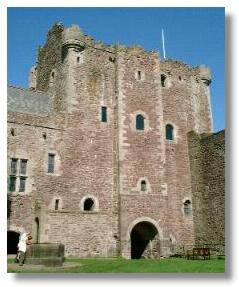
Early History
Doune in Stirlingshire, is three miles west of Dunblane and eight miles north-west of Stirling. Located in the valley of the river Teith it's strategic importance was recognised early on - there is a Roman fort at Ardoch at the confluence of the river Teith and Ardoch Burn. There are earthworks surrounding the present castle which may indicate that there was an earlier castle on the same site.
Royal Pretensions
The present Doune Castle was established at the end of the 14th century by Robert Stuart, the first Duke of Albany and younger son of King Robert II. When his elder brother, King Robert III became unfit to rule, the Duke of Albany virtually governed Scotland for thirty years, especially after he had starved to death the heir apparent, the Duke of Rothesay (King Robert III's eldest son). So although Doune was not a royal palace at that stage, it was built by someone who was a king in all but name. The rightful King, James I, returned from exile in 1424 after the death of the first Duke of Albany in 1420. King James promptly executed the second Duke of Albany and took over Doune as a royal castle.
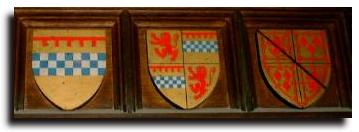
The castle was used as a royal retreat by King James I to VI. It was also used as the residence of the Queens of Scotland, including Mary of Gueldres (wife of James II) and Margaret of Denmark (wife of James III). Sir James Stewart, was created keeper of the castle in the middle of the 16th century. He became Lord Doune in 1570 and when his son married the heiress of the first Earl of Moray, he inherited that title too. Doune has belonged to the Earls of Moray ever since. In the picture above, the crest in the centre is that of Robert Stewart, the first Duke of Albany and that on the right is for James Stewart, the first Earl of Moray. The blue and white diced band is the Stewart symbol and the lion rampant, of course, signifies the descent from the royal line.
Jacobite Uprisings - and an American Connection
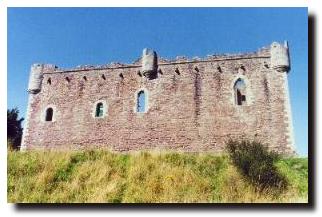 In the Jacobite Uprising of 1745, MacGregor Of Glengyle was appointed as temporary governor by Prince Charles Edward Stuart. After the battle of Falkirk in January 1746, prisoners taken by the Jacobites were interned at Doune - including the young Rev. John Witherspoon who was later to emigrate to America and become one of the architects of the Declaration of Independence and president of Princeton College.
In the Jacobite Uprising of 1745, MacGregor Of Glengyle was appointed as temporary governor by Prince Charles Edward Stuart. After the battle of Falkirk in January 1746, prisoners taken by the Jacobites were interned at Doune - including the young Rev. John Witherspoon who was later to emigrate to America and become one of the architects of the Declaration of Independence and president of Princeton College.
Touring the Castle
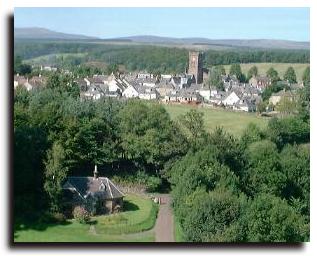 Although the castle lay derelict for many years, a number of restoration works have been undertaken and it is now possible to wander around many parts of the castle. There is an interesting exhibition in the basement of the castle recounting the history of the building and a few of the rooms, including the Great Hall, have reproduction period furniture and the large stone fireplaces associated with such buildings. Visitors can climb to the top of the gate-tower and get a magnificent view of the surrounding countryside, including the pretty little village of Doune, as seen here.
Although the castle lay derelict for many years, a number of restoration works have been undertaken and it is now possible to wander around many parts of the castle. There is an interesting exhibition in the basement of the castle recounting the history of the building and a few of the rooms, including the Great Hall, have reproduction period furniture and the large stone fireplaces associated with such buildings. Visitors can climb to the top of the gate-tower and get a magnificent view of the surrounding countryside, including the pretty little village of Doune, as seen here.
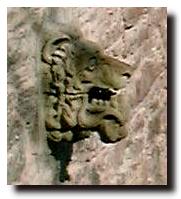 In recent years the castle has gained considerable publicity through being used in the film "Monty Python and the Holy Grail" (it was also used in the film "Ivanhoe" many years earlier) and Python fans have been known to make the pilgimage to Doune for that reason. Michael Palin and Terry Jones, two of the stars in the movie, recently made a return visit to the castle - accompanied by a posse of reporters and cameramen. And if you ask at the visitor centre as you enter the castle, they will be glad to give you a demonstration of the coconut shells which were used as sound effects for horses' hooves in the film!
In recent years the castle has gained considerable publicity through being used in the film "Monty Python and the Holy Grail" (it was also used in the film "Ivanhoe" many years earlier) and Python fans have been known to make the pilgimage to Doune for that reason. Michael Palin and Terry Jones, two of the stars in the movie, recently made a return visit to the castle - accompanied by a posse of reporters and cameramen. And if you ask at the visitor centre as you enter the castle, they will be glad to give you a demonstration of the coconut shells which were used as sound effects for horses' hooves in the film!



